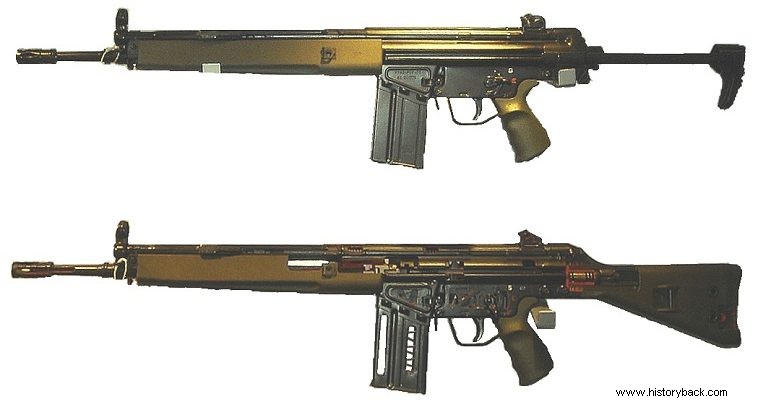
In the late 1950s the German army was looking for a new rifle. The then West German armed forces were established in 1955, 10 years after the end of World War II. German soldiers were initially equipped with American M1 Garand rifles. However, as the Warsaw Pact forces were equipped with the excellent AK-47 Kalashnikov, the German forces then forming the front line of NATO could not be far behind.
German Mauser technicians Ludwig Vorgrimler and Theodor Leffler were transferred to France after WWII. There based on the Sturmgewehr 45 they developed a series of assault rifles that can be called ancestors of the G3. These rifles were tested but never went into production.
In 1950 Forgrimler moved to Spain and worked for CEMTE (Centro de Estudios Técnicos de Materiales Especiales) . There he built prototypes in the caliber of 7.92 mm. The West Germans showed interest in the M2 rifle he built and approached the Spanish company, but requested that its caliber be modified to 7.62x51mm. The CEMTE Model A as it was called did not satisfy the Germans.
Thus, with the collaboration of CEMTE and the German Heckler &Koch, the Modelo B or Gewehr 3 was developed. The weapon was adopted in 1958 by the Spanish army. CEMTE's weapon entered the German army in 1959 under the designation G3.
It was a cheap but reliable rifle with metal and plastic parts and with, in theory, a longer range than the AK-47. It could fire a shell from the barrel without modifications. The basic model was the G3A3, followed by the G3A4 with the folding metal stock. The G3 was adopted almost immediately by dozens of militaries around the world. In addition to the German G3, the Greek, Swedish, Dutch, Norwegian, Portuguese, Spanish, British, Luxembourg, Danish and Turkish armies in Europe were equipped.
In the Middle East it armed the forces of Saudi Arabia, Pakistan, then North Yemen and the United Arab Emirates. It was also manufactured under license in Iran, while the armies of Ethiopia, Angola and Zaire also acquired the rifle, as did those of Thailand and Myanmar and many other African and Asian states.
In total the rifle was adopted by more than 40 armies around the world, while in 18 countries it was produced domestically. The rifle works with the delayed recoil system. It is fed with a magazine of 20 cartridges. The exit velocity of the ball from the barrel is of the order of 800 m per second, the maximum range 3,700 m and the maximum theoretical velocity 500-600 balls per minute. The practical firing speed is in the order of 30-90 fireballs per minute.
